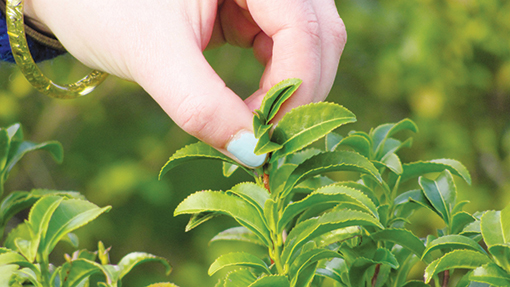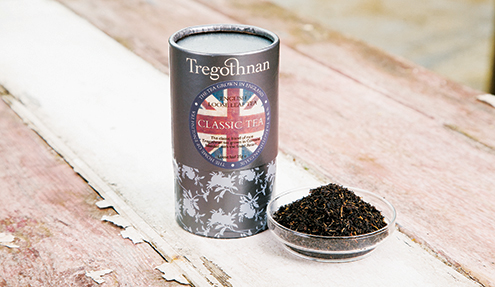The Cornish estate farming British tea

Whether it’s afternoon tea, a tea break or time for a brew, nothing says British like a steaming cup of tea, yet ironically Britain has never been known for growing tea – until now.
On the tip of Cornwall, the Tregothnan Estate is putting the English back into Britain’s favourite drink by pioneering the growth of Camellia sinensis – the bush used to produce tea leaves.
Not only is it leading the way as the only commercial grower in the UK, it is also taking it one step further by selling the product back to China – the birthplace of tea more than 5,000 years ago.
Such is the estate’s success they are in the process of developing a chain of global shops selling the English tea experience to China and the world.
The groundbreaking work carried out by the estate is fitting, considering the role Britain has always played in developing the global industry.
By driving the establishment of tea plantations in regions of India and Africa and importing leaves back to Britain 400 years ago, tea quickly became the nation’s number one drink.
However, historically the British cuppa has always relied on imported leaves due to generally unfavourable UK growing conditions.
For the Boscawen family, the unique climate on the Tregothnan Estate has proved crucial to the success of their plantations.
Situated 10 miles inland, just east of Truro, the estate’s equable climate is moderated by the Atlantic Ocean. The humid sea air, which loses its damaging saltiness before it reaches the estate, perfectly mimics conditions in the high foothills of the Himalayas. This ideal tea-growing climate appears unique to this pocket of the country, with growing attempts failing in other regions of the UK.
Historically the Tregothnan Estate had been the first in the UK to grow ornamental tea outside 200 years ago. However it was managing director Jonathon Jones who introduced the first Camellia sinensis bush to the estate in 1999.
Jonathon’s experience living and working in Japan made him aware of the hardiness and diversity of the tea plant. Further travels in 2001 as part of his Nuffield Farming Scholarship provided the knowledge to make tea growing a feasible commercial option.
“The more I travelled, the more reasons I found to do it,” says Jonathon. “My Nuffield confirmed it was the China-type varieties, which had been taken by the Brits from China to India and Africa, that were right for us.”
These delicate, light varieties would be suited to the estate’s climate, which was similar to that of the Darjeeling growing regions.
Sourcing the right kind of plant then became the next challenge. As word spread of the estate’s plans, it started to receive plant donations from individuals and botanical gardens, which allowed it to build a genetic base.
“Our focus first was to bulk up what we had, so we started to take cuttings to propagate,” says Jonathon.
A significant investment of time was necessary, as it takes three to four years for a plant to reach a stage where its leaves can be plucked. Once established, a bush can last for 400 years, but the early establishment stage is highly risky, says Jonathon.
“You can get an 80% death rate from cutting to planting outside at 18-24 months. Misting is important during propagation in greenhouses. camellia needs a humid, warm environment for propagation.”
After nine months, plants are moved into pots and then put outside to harden off. At two to three years old, when plants are about 30-35cm high, they can then be planted in fields, known as “gardens”.
Having originally planted less than an acre in 2000 and sold its first cup in 2005, the estate now has about 100 acres grown across several small blocks of land. This includes Camellia sinensis, assamica and some hybrid varieties. A total of 10t of tea is produced every year, with some leaves that don’t grow as well in Cornwall imported to make blends.
“Not all of the 100 acres is fully productive. We will start lightly plucking bushes when they’re three to four years old, with about 10% of the bush plucked. This with then increase to 100% when it reaches year six or seven,” explains Jonathon.
At three to four years old, a bush typically yields about 50g of tea – or 25 cups – at its first plucking. This increases to about 100g in year six to seven.
“We pick in April to October and take the top two leaves. It’s a lot like privet hedges in the sense you know when it needs cutting. Depending on temperature and growth rate, you can pluck again about eight weeks later.”
Soil and water pH, along with weed control, are also crucial. Bushes thrive in acid soils of about pH4 and like similar soft, acidic water. Tea is also nitrogen-hungry and receives farmyard matter, leaf compost and some artificial nitrogen as needed.
From bush to cup is a five-stage process including plucking, withering, rolling, oxidising and drying. This is all largely done by hand or handheld machinery.
Tea trivia
- Once established, a bush can last for more than 400 years
- Tea constitutes 40% of the UK’s daily liquid intake
- 165m cups are drunk in the UK every day
- Americans spend more per head on tea than Brits
- Chinese companies are planning to grow tea at Tregothnan in Cornwall.
The first flush is picked in the morning, with two leaves and a bud taken from each bush. “Mornings are better for plucking as the leaves are turgid and last longer in transit,” explains Jonathon.
“Leaves are then laid on bamboo racks to allow withering. Rolling then takes place if we are processing black tea. This can literally mean rolling the leaves between two surfaces,” Jonathon explains.
Leaves then undergo oxidation by being spread on a flat surface and kept at a controlled temperature. This is when they turn from green to black. The final stage is to dry the leaves to 2% moisture. Just 36 hours after plucking the tea is ready for drinking.

From the outset, Tregothnan has aimed to produce an exclusive, luxury product, with tea originally stocked solely at Fortnum & Mason. However as news of the unique British plantation spread, so has the market.
“Our story has captured the imagination of tea drinkers throughout the UK, Europe, America, Japan and beyond. Today the range includes four black teas, one green tea and a growing number of herbal infusions,” says Jonathon.
Since February this year, Tregothnan branded tea can also be found in 200 Waitrose stores. However, the export market dominates sales.
“We’ve had strong interest from overseas with 80% of Tregothnan tea destined for export. The Chinese market is particularly receptive. We took the Chinese national drink, made it our national drink and now sell the whole tea experience back to them.”
The estate plans to set up a chain of global, contemporary shops selling a range of teas from around the world as well as the Tregothnan brand. These Starbucks-style shops will market the whole British experience, including afternoon tea with scones, clotted cream and jam.
